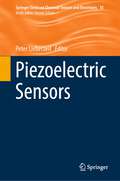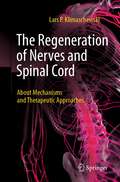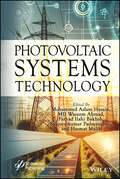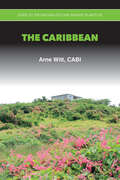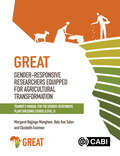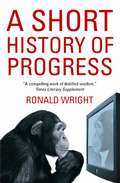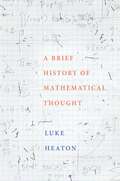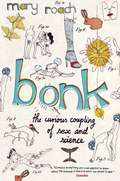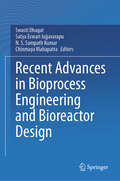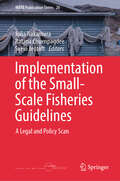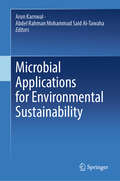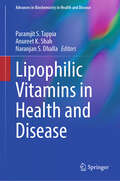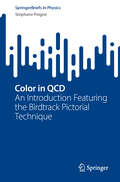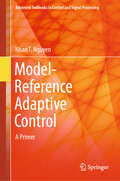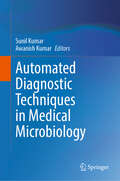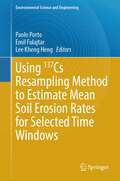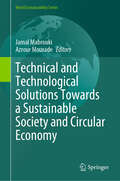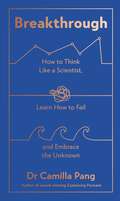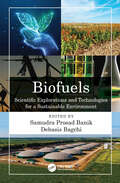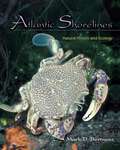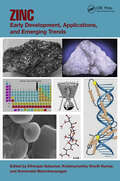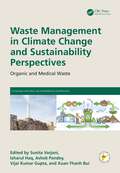- Table View
- List View
Piezoelectric Sensors (Springer Series on Chemical Sensors and Biosensors #18)
by Peter LieberzeitThis book provides a comprehensive overview of piezoelectric sensor devices and instrumentation and their use for chemical and biochemical analysis. Sensors relying on established transducers, such as the quartz crystal microbalance (QCM) and the surface acoustic wave resonator (SAW) are covered, and novel devices like surface transverse wave (STW) resonators, film bulk acoustic resonators (FBAR) as well as non-piezoelectric devices with mass-sensitive properties are presented. As their name implies, such devices respond directly to mass changes on their surfaces and thus address the most fundamental quality of any analytes. First, the book presents the fundamentals of new measuring strategies with these devices. Then, it introduces a variety of chemo- and biosensing application scenarios of these devices. In addition, the book covers both the state-of-the-art of academic research and prospects concerning the commercialization of these sensors. Given its scope, the book is of interest to academics, specialists in industry, and advanced students in the areas of analytical chemistry, rapid analysis, and sensor technology, giving them the unique possibility to familiarize themselves with this chemical sensing strategy. Readers will benefit from the coverage of both cutting-edge research results and applications that help bridge the gap between academia and industry.
The Regeneration of Nerves and Spinal Cord: About Mechanisms and Therapeutic Approaches
by Lars P. KlimaschewskiThis non-fiction book provides information about the latest findings on research and therapy of nerve regeneration with catchy drawings and in understandable words. Why do nerves in the extremities regenerate, but the axons in the spinal cord do not? Can transplanted stem cells or biopolymers restore regeneration? Are bioprostheses able to functionally replace amputated arms or legs? Neuroscientist Lars Klimaschewski answers these questions and reports on exciting findings from anatomy, cell and molecular biology and neurotechnology. Find out, among other things, how a brain-computer interface processes signals from the brain in order to control the arm or leg muscles again via electrodes after a paraplegia.The translation was done with the help of artificial intelligence. A subsequent human revision was done primarily in terms of content.
Photovoltaic Systems Technology
by Mohammed Aslam Husain Waseem Ahmad Farhad Ilahi Bakhsh P. Sanjeevikumar Hasmat MalikPHOTOVOLTAIC SYSTEMS TECHNOLOGY Discover comprehensive insights into the latest advancements in solar PV technology, including power electronics, maximum power point tracking schemes, and forecasting techniques, with a focus on improving the performance of PV systems. A huge number of research articles and books have been published in the last two decades, covering different issues of PV efficiency, circuits, and systems for power processing and their related control. Books that have been published cover one or more topics but altogether fail to give a complete picture of the different aspects of PV systems. Photovoltaic Systems Technology aims to close the gap by providing a comprehensive review of techniques/practices that are dedicated to improving the performance of PV systems. The book is divided into three parts: the first part is dedicated to advancements in power electronic converters for PV systems; tools and techniques for maximum power point tracking of PV systems will be covered in the second part of the book; and the third part covers advancements in techniques for solar PV forecasting. The overall focus of the book is to highlight the advancements in modeling, design, performance under faulty conditions, forecasting, and application of solar photovoltaic (PV) systems using metaheuristic, evolutionary computation, machine learning, and AI approaches. It is intended for researchers and engineers aspiring to learn about the latest advancements in solar PV technology with emphasis on power electronics involved, maximum power point tracking (MPPT) schemes, and forecasting techniques.
Guide to the Naturalized and Invasive Plants of the Caribbean
by Arne WittThe Caribbean region is one of the world's greatest centres of biodiversity. It includes about 11,000 species of plants of which 72% are found nowhere else on earth. Endemic vertebrates include all of the 189 species of amphibians present in the Caribbean; 95% of the 520-reptile species; 26% of the 564-bird species; and 74% of the 69 species of mammals, mostly bats. Species endemic to this hotspot represent 2.6% of the world's plant species and 3.5% of the world's vertebrate species. This biodiversity, and the livelihoods of people that depend on it are threatened by, among others, the uncontrolled spread of invasive alien species (IAS). This Field Guide has been developed to help address one of the barriers to effective IAS management, which is the lack of information on the presence, impact and management of invasive alien plant species in the Caribbean. In general, we have only included those species that we consider to be threatening biodiversity and livestock production.
Gender-responsive Researchers Equipped for Agricultural Transformation, Level 2.: Trainer’s Manual for the Gender-Responsive Plant Breeding Course
by Dr Margaret Najjingo Mangheni Professor Hale Ann Tufan Dr Elizabeth AsiimweThis manual presents the training process for the Gender-Responsive Plant Breeding course, implemented by Makerere and Cornell Universities, over a period of five years (2016-2020), under the Gender-Responsive Researchers Equipped for Agricultural Transformation (GREAT) project funded by the Bill and Melinda Gates Foundation. It has five broad parts: I) Introduction; II) Required preparation before the course; III) Phase one (9-day, face-to-face training); IV) the 5-month Field Training phase; and V) Phase two (5-day, face-to-face training). Each session consists of specific learning objectives, session plans and slides, delivery methods, practical exercises and examples, as well as relevant tips and synthesized take-home messages. The sessions were developed by an international multidisciplinary team of experts in gender and agriculture and subjected to a rigorous peer review and quality assurance process. GREAT aims to contribute to building a pool of gender-responsive agricultural researchers able to advance more equitable and effective agricultural systems in Africa and beyond. This manual is for all facilitators/trainers interested in applied, gender responsive agricultural research.
A Short History Of Progress: Fifteenth Anniversary Edition (Cbc Massey Lectures)
by Ronald WrightHave we learnt the lessons of the past - or will we be next? Many of the great ruins that grace the deserts and jungles of the earth are monuments to civlisations which fell victim to their own success: from Easter Island's monolithic wilderness to the perpetual silence of the Mayan ruins and ultimately to today's melting ice caps and growing ozone hole, the cycle has continually repeated itself across the years.
A Brief History of Mathematical Thought
by Luke HeatonAdvertisements for the wildly popular game of Sudoku often feature the reassuring words, "no mathematical knowledge required." In fact, the only skill Sudoku does require is the use of mathematical logic. For many people, anxiety about math is so entrenched, and grade school memories so haunting, that these disclaimers - though misleading - are necessary to avoid intimidating potential buyers. In A Brief History of Mathematical Thought, Luke Heaton provides a compulsively readable history that situates mathematics within the human experience and, in the process, makes it more accessible. Mastering math begins with understanding its history. Heaton's book therefore offers a lively guide into and through the world of numbers and equations-one in which patterns and arguments are traced through logic in the language of concrete experience. Heaton reveals how Greek and Roman mathematicians like Pythagoras, Euclid, and Archimedes helped shaped the early logic of mathematics; how the Fibonacci sequence, the rise of algebra, and the invention of calculus are connected; how clocks, coordinates, and logical padlocks work mathematically; and how, in the twentieth century, Alan Turing's revolutionary work on the concept of computation laid the groundwork for the modern world. A Brief History of Mathematical Thought situates mathematics as part of, and essential to, lived experience. Understanding it does not require the application of various rules or numbing memorization, but rather a historical imagination and a view to its origins. Moving from the origin of numbers, into calculus, and through infinity, Heaton sheds light on the language of math and its significance to human life.
Bonk: The Curious Coupling Of Sex And Science
by Mary RoachFew things are as fundamental to human happiness as sex, and few writers are as entertaining about the subject as Mary Roach. Can a woman think herself to orgasm? Is your penis three inches longer than you think? Why doesn't Viagra help women - or, for that matter, pandas? Does orgasm boost fertility? Or cure hiccups? The study of sexual physiology - what happens, and why, and how to make it happen better - has been taking place behind closed doors for hundreds of years. In this fascinating and funny book, Mary Roach steps inside laboratories, brothels, pig farms, sex-toy R&D labs - even Alfred Kinsey's attic - to tell us everything we wanted to know about sex, and a lot we'd never even thought to ask.
Recent Advances in Bioprocess Engineering and Bioreactor Design
by Swasti Dhagat Satya Eswari Jujjavarapu N. S. Sampath Kumar Chinmaya MahapatraThis book provides insights into the recent developments in the field of bioprocess technology and bioreactor design. Bioprocess engineering or biochemical engineering is a subcomponent of chemical engineering, which encompasses designing and developing those processes and equipment that are required for the manufacturing of products from biological materials and sources, such as agriculture, pharmaceutical, chemicals, polymers, food, etc., or for the treatment of environmental process, for example, waste water. The main focus of this book is to highlight the advancements in the field of bioprocess technology and bioreactor design. The book is divided into various chapters briefing all aspects of bioprocess engineering and focusing on the advances in bioprocess engineering. The book summarizes introduction to bioprocess technology and microbiology, isolation and maintenance of microbial strains, and sterilization techniques for advanced-level students and researchers. Different models depicting kinetics of microbial growth, substrate consumption, and product formation are discussed. The applications of enzymes have increased tremendously and therefore understanding their metabolic pathways to increase yields is also briefly discussed. The calculations of mass and energy balances associated with entropy changes and free energy. This book also covers the approaches for handling different types of cell cultures and current advancements in the area of bioprocess strategies for different culture types, which scientists and researchers working in the different cell cultures can refer to. The downstream processing of various industrially important products is also a part of this book. Apart from that, the process economics which ensures the feasibility and quality of any biological process is also dealt with as the last section of the book.
Implementation of the Small-Scale Fisheries Guidelines: A Legal and Policy Scan (MARE Publication Series #28)
by Julia Nakamura Ratana Chuenpagdee Svein JentoftThis book provides a transdisciplinary assessment of multiple countries’ legal and policy frameworks vis-à-vis the Voluntary Guidelines for Securing Sustainable Small-Scale Fisheries in the Context of Food Security and Poverty Eradication, adopted in 2014 by the Committee on Fisheries of the Food and Agriculture Organization of the United Nations. Based on an appraisal framework used to facilitate the unpacking of those frameworks, this book collects country experiences and regional perspectives on a range of cross-cutting issues underpinning the protection of the rights and the promotion of justice for small-scale fishers and their communities.This book aims to be the first collection to present a systematic and in-depth assessment of existing national legal and policy frameworks vis-à-vis the SSF Guidelines. This assessment is done through the transdisciplinary and collaborative work of researchers, governments, and civil society organizations for the analysis of the cross-thematic questions, which the contributors of this book aim to address. Firstly, what are the relevant laws and policies that matter for securing rights of small-scale fishers and their communities? How are small-scale fisheries defined by national laws and policies? How are small-scale fisheries treated (i.e., specifically or generally) in these instruments? Are there specific provisions and references to small-scale fisheries or any of its associated terminologies (e.g., artisanal, subsistence, traditional, indigenous)? Secondly, how the relevant instruments address the 8 small-scale fisheries key issues outlined in that rapid appraisal study? What are the strengths and gaps in these instruments? Do they address issues that are not covered by the SSF Guidelines? Do they contribute to clarifying other legal issues that are relevant for sustainable small-scale fisheries? Finally, since the book also aims to explore the accessibility of these legal and policy instruments for those to which they matter the most (the small-scale fishers), the following questions were also considered: What challenges do they face in knowing and understanding the relevant laws and policies in place? Which tools, measures and processes are available in the countries to ensure small-scale fishers can claim for their rights? To what extent judicial courts have recognized and/or granted rights to small-scale fishers?Chapters 11 and 20 are available open access under a Creative Commons Attribution 4.0 International License via link.springer.com.
Microbial Applications for Environmental Sustainability
by Arun Karnwal Abdel Rahman Mohammad Said Al-TawahaThis book focuses on the various applications of microorganisms for sustainable environment and the reduction of hazardous pollutants released in various forms, including xenobiotics, e-waste, pesticides, insecticides, plastic, heavy metals, paper waste, medical waste, textile dyes, and their impact on environmental and human health. The book involves a series of research reports that explain the application of microbes used to solve real-life issues raised due to changes happening in environment, including pollution, by covering applications, including the use of bacteria, fungi, microalgae and biofilm in the detection and degradation of crude oil, pesticides, dyes, e-waste, heavy metals and other pollutants. It also focuses on integrative strategies in the application of microbial nanomaterials for remediation of pollutant. This material will help environmental scientists and microbiologists to learn about existing environmental problems and suggest novel ways to control or contain their effects by employing various treatment approaches.
Lipophilic Vitamins in Health and Disease (Advances in Biochemistry in Health and Disease #28)
by Paramjit S. Tappia Anureet K. Shah Naranjan S. DhallaThe concept of “vital amines” as essential nutrients was introduced over a century ago by Dr Casimir Funk. It was suggested that there is a family of organic substances that are required in minute amounts and essential for life. The increase in incorporation of vitamins and supplementation in routine dietary practices is expected to increase. In fact, it has been estimated that 60% of worldwide consumers are taking vitamin supplements on a daily basis, a trend that will most likely rise across the world.This book brings together international experts in the field of vitamins for human health and disease, to update and integrate current understanding on the effects of different lipophilic vitamins on cellular, metabolic and molecular biochemical reactions with respect to different pathophysiological conditions including cardiovascular disease, cancer, metabolic defects, inflammatory and immune diseases. This book is uniquely positioned as it focuses on the biochemistry and molecular biology of lipophilic vitamins in diverse cell systems in relation to human health and disease.The book will certainly stimulate and motivate biomedical researchers and scientists to further explore the relationship between lipophilic vitamins and biological processes, as well as serve as a highly useful resource for nutritional investigators, health professionals, medical students, fellows, residents and graduate students. We hope that the reader will gain knowledge and further understanding of the importance of lipophilic vitamins. The novel insights provided by the contributing authors will assist in advancing preventive medicine worldwide as well as bring forward knowledge that may help in the use of lipophilic vitamins as adjuvant to therapeutic strategies for human disease.
Color in QCD: An Introduction Featuring the Birdtrack Pictorial Technique (SpringerBriefs in Physics)
by Stéphane PeignéThis book introduces readers to the fascinating world of quantum chromodynamics (QCD) and quarks and gluons, the elementary constituents of protons, neutrons, and all hadrons. Specifically, it focuses on the color of quarks and gluons, responsible for their mutual interactions via the strong force. The book provides an elementary introduction to the birdtrack technique, which is a powerful tool for addressing the color structure of QCD in a pictorial way. The technique shows how quark and gluon colors are combined and mixed in QCD. The author discusses color conservation, shows how to project on color states of systems of quarks, antiquarks, and gluons, how to derive their color charges. The book is enriched with many exercises integrated in the text to learn by doing.This book is primarily intended for particle physics students, graduates, and researchers working in the field of QCD. However, it requires no specific prerequisites in QCD, so it may also be of interest to students of mathematics, as an illustration of the use of the birdtrack pictorial technique in representation theory.
Model-Reference Adaptive Control: A Primer (Advanced Textbooks in Control and Signal Processing)
by Nhan T. NguyenThis textbook provides readers with a good working knowledge of adaptive control theory through applications. It is intended for students beginning masters or doctoral courses, and control practitioners wishing to get up to speed in the subject expeditiously. Readers are taught a wide variety of adaptive control techniques starting with simple methods and extending step-by-step to more complex ones. Stability proofs are provided for all adaptive control techniques without obfuscating reader understanding with excessive mathematics. The book begins with standard model-reference adaptive control (MRAC) for first-order, second-order, and multi-input, multi-output systems. Treatment of least-squares parameter estimation and its extension to MRAC follow, helping readers to gain a different perspective on MRAC. Function approximation with orthogonal polynomials and neural networks, and MRAC using neural networks are also covered. Robustness issues connected withMRAC are discussed, helping the student to appreciate potential pitfalls of the technique. This appreciation is encouraged by drawing parallels between various aspects of robustness and linear time-invariant systems wherever relevant. Following on from the robustness problems is material covering robust adaptive control including standard methods and detailed exposition of recent advances, in particular, the author’s work on optimal control modification. Interesting properties of the new method are illustrated in the design of adaptive systems to meet stability margins. This method has been successfully flight-tested on research aircraft, one of various flight-control applications detailed towards the end of the book along with a hybrid adaptive flight control architecture that combines direct MRAC with least-squares indirect adaptive control. In addition to the applications, understanding is encouraged by the use of end-of-chapter exercises and associated MATLAB® files. Readers will need no more than the standard mathematics for basic control theory such as differential equations and matrix algebra; the book covers the foundations of MRAC and the necessary mathematical preliminaries.
Automated Diagnostic Techniques in Medical Microbiology
by Sunil Kumar Awanish KumarThis book will explore the knowledge of current diagnostic automation techniques applied in the field of clinical microbiology, tropical diseases, POCT, etc. There is no such type of book related to this topic. This book will help clinicians, microbiologists, and researchers to make diagnostic algorithms for infectious diseases and help them in early diagnosis. Automation in clinical microbiology has revolutionized routine practice in diagnostic cum research in medical microbiology. This book covers the recent updates and advances in diagnostic microbiology and provides new techniques related to Genomic, Proteomic, and metabolomics in microbiology. This book will intensely discuss the new and innovative automation techniques available for diagnosis in the microbiology laboratory. This book is more focused on automation techniques, which are used in the early detection of infectious diseases even caused by rare microorganisms. Furthermore, this book has complied with the chapters that provide insights to readers with comprehensive and usable knowledge on automation techniques in diagnostic microbiology.
Using 137Cs Resampling Method to Estimate Mean Soil Erosion Rates for Selected Time Windows (Environmental Science and Engineering)
by Paolo Porto Emil Fulajtar Lee Kheng HengThis book provides guidelines for using a new approach of resampling the Cs-137 radionuclide tracer which is used to estimate soil erosion rates. The Cs-137 resampling approach will improve significantly the use of the Cs-137 method for assessment of soil erosion, because resampling the radionuclide repeatedly (at least two times, but more sampling campaigns are possible) allows to avoid several methodological difficulties associated with Cs-137 method, namely the problems with small-scale spatial heterogeneity, the question of representativeness of reference site, reference samples, and inappropriate time extent of evaluated period. All these methodological problems are very important for reliability and accuracy of erosion rates estimated by Cs-137 method. If using single sampling approach, the small-scale spatial heterogeneity can be overcome by high number of sampling points, but this is time and labour demanding solution increasing the expenses of the erosion research. The representativeness of reference site is evaluated usually on the basis of expert judgement and knowledge of land use history of studied area, but this approach is often uncertain because the expert judgement can be subjective and the data on land use history is often not sufficient. Further, in many areas an appropriate reference site is not available, what limits the territorial extent of using Cs-137 method. The resampling approach offers its second sampling to be done in a proximate vicinity of the same points sampled during the first sampling campaign. A great advantage is the possibility to decide how long time windows should be investigated. Choosing the time schedule of first and second sampling allows to shorten the time window and adjust it to the study objectives. This is a great improvement of the Cs-137 method, because the time period since the Cs-137 fallout is still growing and thus if using the single sampling approach the results refer to still longer and longer time window(since the Cs-137 fallout until the sampling time), and this period (recently ca 60 years assuming the maximum Cs-137 fallout in 1963) is too long to represent stable land use, because land uses are changing over the time and having the same land use over six decades is rather rare. The improvement of Cs-137 method achieved by resampling approach is significantly contributing to understanding the erosion dynamics and estimating its rates under changing environmental conditions (such as land uses, weather), and it will bring a significant benefit to soil conservation programmes, because Cs-137 method is indispensable for assessing the medium and long term soil erosion rates, and this information is among the basic inputs needed for planning and designing soil conservation measures.
Technical and Technological Solutions Towards a Sustainable Society and Circular Economy (World Sustainability Series)
by Jamal Mabrouki Azrour MouradeResource depletion and ecological risks are more than ever at the heart of societal and economic debates. In the 1970s, the developed countries saw the Fordist growth regime crumble in parallel with the growing awareness of the ecological issue. Since the first industrial revolutions, technological dynamics have been the cause of many environmental problems, and there is a consensus on the diagnosis. Integrated technologies reduce resource use and/or pollution at source by using cleaner production methods. This generally leads to a reduction in the by-products, energy inputs and resources used by companies to produce goods.Integrated production technologies reduce negative environmental impacts at source by substituting or modifying cleaner technologies. Examples of integrated, or cleaner, production technologies are the recirculation of materials, the use of environmentally friendly materials (such as the substitution of water for organic solvents), etc. However, the implementation of integrated production technologies is often hampered by obstacles related to cost, coordination and skill inertia problems and to the productive organisation of companies. In addition to the high investment costs of new integrated technologies, additional barriers may emerge depending on the nature of the environmental problem and the type of environmental regulation in question.
Breakthrough: How to Think Like a Scientist, Learn to Fail and Embrace the Unknown
by Camilla PangA scientist’s journey from observation to discovery is anything but straightforward. It is littered with failure, unexpected diversions and joyous realizations. Science helps us to understand ourselves – but what we know about the world around us, what has already been explored and discovered, is only half of science’s story.Dr Camilla Pang will look at some of the biggest mysteries facing science today and how some of the best, most cutting-edge scientists can illuminate our own approaches to observation, hypothesis, exploration, troubleshooting and discovery in our own lives. Breakthrough explores the frontier between what we do and don’t know about the world: where knowledge meets mystery, complexity overwhelms certainty, and the vastness of our universe unspools the logic of science's established laws.There's a scientist hidden inside all of us. Science's greatest gift to us is not formulae but enabling the urge to discover that makes us truly human.
Biofuels: Scientific Explorations and Technologies for a Sustainable Environment
by Samudra Prosad Banik Debasis BagchiBiofuels are promising eco-friendly, renewable energy alternatives, simultaneously curbing the dependence on depleting fossil fuel reserves, reducing the global carbon footprint. However, there have been technological constraints deterring the global wide-scale adoption of biofuel. Biofuels: Scientific Explorations and Technologies for a Sustainable Environment presents a comprehensive analysis of different types of biofuels. Five sections provide detailed information on the history and discovery of biofuels, first-generation biofuels, second-generation biofuels, third-generation biofuels, and beyond, as well as prospects of biofuels as cleaner and greener alternatives.FEATURES Introduces the history of the origin of biofuels Narrates the evolution of biofuel raw material beyond generations, from food crops to plastic waste Explains the application of primary biofuel types: biodiesel, bioethanol, and biohydrogen Discusses the promises and prospects of biofuel for a cleaner, sustainable future Biofuels: Scientific Explorations and Technologies for a Sustainable Environment analyzes the promising future of biofuel technology and its judicious use to minimize dependency on fossil fuels. It is designed for academia, scientists, and researchers, as well as industrialists, environmentalists, biofuel technicians, R&D industries, and those from the petroleum industry.
Biofuels: Scientific Explorations and Technologies for a Sustainable Environment
Biofuels are promising eco-friendly, renewable energy alternatives, simultaneously curbing the dependence on depleting fossil fuel reserves, reducing the global carbon footprint. However, there have been technological constraints deterring the global wide-scale adoption of biofuel. Biofuels: Scientific Explorations and Technologies for a Sustainable Environment presents a comprehensive analysis of different types of biofuels. Five sections provide detailed information on the history and discovery of biofuels, first-generation biofuels, second-generation biofuels, third-generation biofuels, and beyond, as well as prospects of biofuels as cleaner and greener alternatives.FEATURES Introduces the history of the origin of biofuels Narrates the evolution of biofuel raw material beyond generations, from food crops to plastic waste Explains the application of primary biofuel types: biodiesel, bioethanol, and biohydrogen Discusses the promises and prospects of biofuel for a cleaner, sustainable future Biofuels: Scientific Explorations and Technologies for a Sustainable Environment analyzes the promising future of biofuel technology and its judicious use to minimize dependency on fossil fuels. It is designed for academia, scientists, and researchers, as well as industrialists, environmentalists, biofuel technicians, R&D industries, and those from the petroleum industry.
Atlantic Shorelines: Natural History and Ecology
by Mark D. BertnessA comprehensive introduction to the natural history and intertidal ecology of East Coast shorelinesAtlantic Shorelines is an introduction to the natural history and ecology of shoreline communities on the East Coast of North America. Writing for a broad audience, Mark Bertness examines how distinctive communities of plants and animals are generated on rocky shores and in salt marshes, mangroves, and soft sediment beaches on Atlantic shorelines.The book provides a comprehensive background for understanding the basic principles of intertidal ecology and the unique conditions faced by intertidal organisms. It describes the history of the Atlantic Coast, tides, and near-shore oceanographic processes that influence shoreline organisms; explains primary production in shoreline systems, intertidal food webs, and the way intertidal organisms survive; sets out the unusual reproductive challenges of living in an intertidal habitat, and the role of recruitment in shaping intertidal communities; and outlines how biological processes like competition, predation, facilitation, and ecosystem engineering generate the spatial structure of intertidal communities.The last part of the book focuses on the ecology of the three main shoreline habitats—rocky shores, soft sediment beaches, and shorelines vegetated with salt marsh plants and mangroves—and discusses in detail conservation issues associated with each of them.
Atlantic Shorelines: Natural History and Ecology
by Mark D. BertnessA comprehensive introduction to the natural history and intertidal ecology of East Coast shorelinesAtlantic Shorelines is an introduction to the natural history and ecology of shoreline communities on the East Coast of North America. Writing for a broad audience, Mark Bertness examines how distinctive communities of plants and animals are generated on rocky shores and in salt marshes, mangroves, and soft sediment beaches on Atlantic shorelines.The book provides a comprehensive background for understanding the basic principles of intertidal ecology and the unique conditions faced by intertidal organisms. It describes the history of the Atlantic Coast, tides, and near-shore oceanographic processes that influence shoreline organisms; explains primary production in shoreline systems, intertidal food webs, and the way intertidal organisms survive; sets out the unusual reproductive challenges of living in an intertidal habitat, and the role of recruitment in shaping intertidal communities; and outlines how biological processes like competition, predation, facilitation, and ecosystem engineering generate the spatial structure of intertidal communities.The last part of the book focuses on the ecology of the three main shoreline habitats—rocky shores, soft sediment beaches, and shorelines vegetated with salt marsh plants and mangroves—and discusses in detail conservation issues associated with each of them.
Zinc: Early Development, Applications, and Emerging Trends
by Ethirajan Sukumar Krishnamurthy Vinoth Kumar Annamalai ManickavasaganZinc: Early Development, Applications, and Emerging Trends is a comprehensive book covering various aspects of the metallic element zinc that has a significant role in the growth and survival of humans. The United Nations Organization has aptly declared it as a ‘Life-Saving Material’ since it helps in overcoming infections and strengthening the immune system. Zinc is an essential element next to iron, aluminum, and copper with abundant presence in nature, and is worth billions of dollars commercially. Besides the metal, its compounds and nanoparticles have also become attractive to researchers due to their enormous applications. The industrial and agricultural uses of the metal and its compounds are widespread.An exclusive book covering all important aspects of zinc is yet to hit the market. This book, with contributions from experts in geology, chemistry, medicine (including dentistry and traditional systems), agriculture, veterinary science, biology, bioinformatics, and nanotechnology encompassing the latest developments in their fields related to zinc, fills this void. The uniqueness of the book is its interdisciplinary nature and potential use by researchers, students, and teachers of various specialties.Features: Contributes to a better understanding of the complexities of zinc’s role in various branches of science Contains basic and practical information for a wider audience and researchers of different fields besides those interested in zinc Provides detailed information on the usefulness of zinc in prophylaxis and treatment of diseases in modern medicine, dentistry, and traditional systems such as Ayurveda, Siddha, and Unani, as well as veterinary medicine Highlights zinc’s role in agriculture and food science with various crops and nutritive materials Includes chapters on fast-growing areas – nanotechnology and bioinformatics
Zinc: Early Development, Applications, and Emerging Trends
Zinc: Early Development, Applications, and Emerging Trends is a comprehensive book covering various aspects of the metallic element zinc that has a significant role in the growth and survival of humans. The United Nations Organization has aptly declared it as a ‘Life-Saving Material’ since it helps in overcoming infections and strengthening the immune system. Zinc is an essential element next to iron, aluminum, and copper with abundant presence in nature, and is worth billions of dollars commercially. Besides the metal, its compounds and nanoparticles have also become attractive to researchers due to their enormous applications. The industrial and agricultural uses of the metal and its compounds are widespread.An exclusive book covering all important aspects of zinc is yet to hit the market. This book, with contributions from experts in geology, chemistry, medicine (including dentistry and traditional systems), agriculture, veterinary science, biology, bioinformatics, and nanotechnology encompassing the latest developments in their fields related to zinc, fills this void. The uniqueness of the book is its interdisciplinary nature and potential use by researchers, students, and teachers of various specialties.Features: Contributes to a better understanding of the complexities of zinc’s role in various branches of science Contains basic and practical information for a wider audience and researchers of different fields besides those interested in zinc Provides detailed information on the usefulness of zinc in prophylaxis and treatment of diseases in modern medicine, dentistry, and traditional systems such as Ayurveda, Siddha, and Unani, as well as veterinary medicine Highlights zinc’s role in agriculture and food science with various crops and nutritive materials Includes chapters on fast-growing areas – nanotechnology and bioinformatics
Waste Management in Climate Change and Sustainability Perspectives: Organic and Medical Waste (Sustainable Industrial and Environmental Bioprocesses)
by Sunita Varjani Izharul Haq Ashok Pandey Vijai Kumar Gupta Xuan-Thanh BuiThis handbook discusses the relationships and effects of climate change on waste treatment and its sustainable management. The waste management sector is in a unique position to transition from a minor source of global greenhouse gas (GHG) emissions to a major contributor to reducing GHG emissions. This book compiles the potential impacts and benefits of various waste management systems in terms of climate impact. It investigates the global climate impact of municipal solid waste, commercial and industrial waste, agricultural waste, and hazardous waste management systems.Key features: Reviews advanced and innovative processes for sustainable waste management Covers green waste treatment technologies using microbes, green soldier flies, earthworms and bacteriophages Discusses the negative and positive effects of waste treatment and disposal Provides relevant case studies from different regions of the world Examines the role of climate change on emerging pollutants The book is meant for researchers and professionals in environmental sciences, chemical and biochemical engineering.
